`2000 年 1 月英语六级真题及答案
Part I
Listening Comprehension
(20 minutes)
Section A
Directions: In this section, you will hear 10 short conversations. At the end of
each conversation, a question will be asked about what was said. Both the
conversationandthequestionwill bespokenonlyonce.After eachquestionthere
will be a pause. During the pause, you must read the four choices marked A), B),
C)andD),anddecidewhichisthebestanswer.Thenmarkthecorrespondingletter
on the Answer Sheet with a single line through the center.
Example:
You will hear:
You will read:
A) 2 hours.
B) 3 hours.
C) 4 hours.
D) 5 hours.
Fromthe conversation we knowthat the two were talkingabout some work they will
startat9o’clockinthemorningandhavetofinishat2intheafternoon.Therefore,
D)“5hours”isthecorrectanswer.Youshouldchoose[D]ontheAnswerSheetand
mark it with a single line through the center.
Sample Answer [A] [B] [C] [D]
1. A) To cancel his trip.
B) To go to bed early.
C) To catch a later flight.
D) To ask for a wake-up call.
2. A) They have different opinions as to what to do next.
B) They have to pay for the house by installments.
C) They will fix a telephone in the bathroom.
D) The man’s attitude is more sensible than the woman’s.
3. A) She will save the stamps for the man’s sister.
B) She will no longer get letters from Canada.
C) She can’t give the stamps to the man’s sister.
D) She has given the stamps to the man’s roommates.
4. A) Visiting the Brownings.
B) Writing a postcard.
C) Looking for a postcard.
D) Filling in a form.
5. A) The man should work with somebody else.
B) The man should meet his partner’s needs.
C) They should come to a compromise.
D) They should find a better lab for the project.
6. A) She can’t finish her assignment, either.
.
�
B) She can’t afford a computer right now.
C) The man can use her computer.
D) The man should buy a computer right away.
7. A) The visiting economist has given several lectures.
B) The guest lecturer’s opinion is different from Dr. Johnson’s.
C) Dr. Johnson and the guest speaker were schoolmates.
D) Dr. Johnson invited the economist to visit their college.
8. A) She’s never watched a better game.
B) Football is her favorite pastime.
C) The game has been canceled.
D) Their team played very badly.
9. A) The man should stick to what he’s doing.
B) The man should take up a new hobby.
C) The man should stop playing tennis.
D) The man should find the cause for his failure.
10. A) An invented story.
B) A real life experience.
C) An imaginary situation.
D) A terrible nightmare.
Section B
Directions: In this section, you will hear 3 short passages. At the end of each
passage,you willhearsome questions. Boththe passageand the questions willbe
spoken only once. After you hear a question, you must choose the best answer from
the four choices marked A), B), C) and D). Then mark the corresponding letter on
the Answer Sheet with a single line through the center.
Passage one
Question 11 to 13 are based on the passage you have just heard.
11. A) The name of a German town.
B) A resident of Frankfurt.
C) A kind of German sausage.
D) A kind of German bread.
12. A) He sold fast food.
B) He raised dogs.
C) He was a cook.
D) He was a Cartoonist.
13. A) Because the Americans found they were from Germany.
B) Because people thought they contained dog meat.
C) Because people had to get used to their taste.
D) Because it was too hot to eat right away.
Passage Two
.
�
Questions 14 to 16 are based on the passage you have just heard.
14. A) They give out faint cries.
B) They made noises to drive away insects.
C) They extend their water pipes.
D) They become elastic like rubber bands.
15. A) Quiet plants.
B) Well-watered plants.
C) Healthy plants.
D) Thirsty plants.
16. A) They could drive the insects away.
B) They could keep the plants well-watered.
C) They could make the plants grow faster.
D) They could build devices to trap insects.
Passage Three
Questions 17 to 20 are based on the passage you have just heard.
17. A) To look for a different lifestyle.
B) To enjoy themselves.
C) For adventure.
D) For education.
18. A) There are 200 vehicles for every kilometer of roadway.
B) It has a dense population.
C) There are many museums and palaces.
D) It has many towering buildings.
19. A) It is a city of contrasts.
B) It possesses many historical sites.
C) It is an important industrial center.
D) It has many big and beautiful parks.
20. A) It helps develop our personalities.
B) It enables us to acquire first-hand knowledge.
C) It makes our life more interesting.
D) It brings about changes in our lifestyle.
Part II
Reading Comprehension
(35 minutes)
Direction: There are 4 passages in this part. Each passage is followed by some
questions or unfinished statements. For each of them there are four
choicesmarked A),B)C)and D).Youshoulddecide onthebestchoice
and mark the corresponding letter on the Answer Sheet with a single
line through the center.
Passage One
.
�
Questions 21 to 25 are based on the following passage:
In the world of entertainment, TV talk shows have undoubtedly flooded every inch
of space on daytime television. And anyone who watches them regularly knows that
each one varies in style and format. But no two shows are more profoundly opposite
in content, while at the same time standing out above the rest, than the Jerry
Springer and the Oprah Winfrey shows.
Jerry Springer could easily be considered the king of “trash talk(废话)”.
The topics on his show are as shocking as shocking can be. For example, the show
takes the ever-common talk show themes of love, sex, cheating, guilt, hate, conflict
and morality to a different level. Clearly, the Jerry Springer show is a display
and exploitation of society’s moral catastrophes(灾难), yet people are willing
to eat up the intriguing predicaments(困境)of other people’s lives.
Like Jerry Springer, Oprah Winfrey takes TV talk show to its extreme, but Oprah
goes in the opposite direction. The show focuses on the improvement of society and
an individual’s quality of life. Topics range from teaching your children
responsibility, managing your work week, to getting to know your neighbors.
Compared to Oprah, the Jerry Springer show looks like poisonous waste being
dumped on society. Jerry ends every show with a “final word”. He makes a small
speech that sums up the entire moral of the show. Hopefully, this is the part where
most people will learn something very valuable.
Clean as it is, the Oprah show is not for everyone. The show’s main target
audience are middle-class Americans. Most of these people have the time. Money, and
stability to deal with life’s tougher problems. Jerry Springer, on the other hand,
has more of an association with the young adults of society. These are 18- to
21-year-olds whose main troubles in life involve love, relationship, sex, money and
peers. They are the ones who see some value and lessons to be learned underneath
the show’s exploitation.
While the two shows are as different as night and day. Both have ruled the talk
show circuit for many years now. Each one caters to a different audience while both
have a strong following from large groups of fans. Ironically, both could also be
considered pioneers in the talk show world.
21. Compared with other TV talk shows, both the Jerry Springer and the Oprah Winfrey
are ________________.
A) more family-oriented
B) unusually popular
C) more profound
D) relatively formal
22. Though the social problems Jerry Springer talks about appear distasteful, the
audience _________.
A) remain fascinated by them
B) are ready to face up to them
C) remain indifferent to them
D) are willing to get involved in them
.
�
23. Which of the following is likely to be a topic of the Oprah Winfrey show?
A) A new type of robot.
B) Racist hatred.
C) Family budget planning.
D) Street violence.
24. Despite their different approaches, the two talk shows are both ____________.
A) ironical
B) sensitive
C) instructive
D) cynical
25. We can learn from the passage that the two talk shows ___________.
A) have monopolized the talk show circuit
B) exploit the weaknesses in human nature
C) appear at different times of the day
D) are targeted at different audiences
Passage Two
Questions 26 to 30 are based on the following passage:
To understand the marketing concept, it is only necessary to understand the
difference between marketing and selling. Not too many years ago, most industries
concentrated primarily on the efficient production of goods, and then relied on
“persuasive salesmanship” to move as much of these goods as possible. Such
production and selling focuses on the needs of the seller to produce goods and then
convert them into money.
Marketing, on the other hand, focuses on the wants of consumers. It begins with
first analyzing the preferences and demands of consumers and then producing goods
that will satisfy them. This eye-on-the-consumer approach is known as the marketing
concept, which simply means that instead of trying to sell whatever is easiest to
produce or buy for resale, the makers and dealers first endeavor to find out what
the consumer wants to buy and then go about making it available for purchase.
This concept does not imply that business is benevolent(慈善的)or that consumer
satisfaction is given priority over profit in a company. There are always two sides
to every business transaction – the firm and the customer – and each must be
satisfied before trade occurs. Successful merchants and producers, however,
recognize that the surest route to profit is through understanding and catering to
customers. A striking example of the importance of catering to the consumer presented
itself in mid-1985, when Coca Cola changed the flavor of its drink. The
non-acceptance of the new flavor by a significant portion of the public brought about
a prompt restoration of the Classic Coke, which was then marketed alongside the new
King Customer ruled!
26. The marketing concept discussed in the passage is, in essence, ____________.
A) the practice of turning goods into money
B) making goods available for purchase
C) the customer-centred approach
.
�
D) a form of persuasive salesmanship
27. What was the main concern of industrialists before the marketing concept was
widely accepted?
A) The needs of the market.
B) The efficiency of production.
C) The satisfaction of the user.
D) The preferences of the dealer.
28. According to the passage, “to move as much of these goods as possible” (Lines
3-4, Para. I) means “_______________”.
A) to sell the largest possible amount of goods
B) to transport goods as efficiently as possible
C) to dispose of these goods in large quantities
D) to redesign these goods for large-scale production
29. What does the restoration of the Classic Coke best illustrate?
A) Traditional goods have a stronger appeal to the majority of people.
B) It takes time for a new product to be accepted by the public.
C) Consumers with conservative tastes are often difficult to please.
D) Products must be designed to suit the taste of the consumer.
30. In discussing the marketing concept, the author focuses on ___________.
A) its main characteristic
B) its social impact
C) its possible consequence
D) its theoretical basis
Passage Three
Questions 31 to 35 are based on the following passage:
Conventional wisdom about conflict seems pretty much cut and dried. Too little
conflict breeds apathy(冷漠)and stagnation(呆滞). Too much conflict leads to
divisiveness(分裂) and hostility. Moderate levels of conflict, however, can spark
creativity and motivate people in a healthy and competitive way.
Recent research by Professor Charles R. Schwenk, however, suggests that the
optimal level of conflict may be more complex to determine than these simple
generalizations. He studied perceptions of conflict among a sample of executives.
Some of the executives worked for profit-seeking organizations and others for
not-for-profit organizations.
Somewhat surprisingly, Schwenk found that opinions about conflict varied
systematically as a function of the type of organization. Specifically, managers
in not-for-profit organizations strongly believed that conflict was beneficial to
their organizations and that it promoted higher quality decision making than might
be achieved in the absence of conflict.
Managers of for-profit organizations saw a different picture. They believed that
conflict generally was damaging and usually led to poor-quality decision making in
their organizations. Schwenk interpreted these results in terms of the criteria for
.
�
effective decision making suggested by the executives. In the profit-seeking
organizations, decision-making effectiveness was most often assessed in financial
terms. The executives believed that consensus rather than conflict enhanced
financial indicators.
In the not-for-profit organizations, decision-making effectiveness was defined
from the perspective of satisfying constituents. Given the complexities and
ambiguities associated with satisfying many diverse constituents executives
perceived that conflict led to more considered and acceptable decisions.
31. In the eyes of the author, conventional opinion on conflict is ___________.
A) wrong
B) oversimplified
C) misleading
D) unclear
32. Professor Charles R. Schwenk’s research shows _______________.
A) the advantages and disadvantages of conflict
B) the real value of conflict
C) the difficulty in determining the optimal level of conflict
D) the complexity of defining the roles of conflict
33. We can learn from Schwenk’s research that ___________.
A) a person’s view of conflict is influenced by the purpose of his organization
B) conflict is necessary for managers of for-profit organizations
C) different people resolve conflicts in different ways
D) it is impossible for people to avoid conflict
34. The passage suggests that in for-profit organizations ____________.
A) there is no end of conflict
B) expression of different opinions is encouraged
C) decisions must be justifiable
D) success lies in general agreement
35. People working in a not-for-profit organization _____________.
A) seem to be difficult to satisfy
B) are free to express diverse opinions
C) are less effective in making decisions
D) find it easier to reach agreement
Passage Four
Questions 36 to 40 are based on the following passage:
Imagine eating everything delicious you want—with none of the fat. That would
be great, wouldn’t it?
New “fake fat” products appeared on store shelves in the United States recently,
but not everyone is happy about it. Makers of the products, which contain a compound
called olestra, say food manufacturers can now eliminate fat from certain foods.
Critics, however, say the new compound can rob the body of essential vitamins and
nutrients(营养物)and can also cause unpleasant side effects in some people. So
.
�
it’s up to consumers to decide whether the new fat-free products taste good enough
to keep eating.
Chemists discovered olestra in the late 1960s, when they were searching for a
fat that could be digested by infants more easily. Instead of finding the desired
fat, the researchers created a fat that can’t be digested at all.
Normally, special chemicals in the intestines(肠) “grab” molecules of regular
fat and break them down so they can be used by the body. A molecule of regular fat
is made up of three molecule of substances called fatty acids.
The fatty acids are absorbed by the intestines and bring with them the essential
vitamins A, D, E, and K. When fat molecules are present in the intestines with any
of those vitamins, the vitamins attach to the molecules and are carried into the
bloodstream.
Olestra, which is made from six to eight molecules of fatty acids, is too large
for the intestines to absorb. It just slides through the intestines without being
broken down. Manufacturers say it’s that ability to slide unchanged through the
intestines that makes olestra so valuable as a fat substitute. It provides consumers
with the taste of regular fat without any bad effects on the body. But critics say
olestra can prevent vitamins A, D, E, and K from being absorbed. It can also prevent
the absorption of carotenoids(类胡萝卜素), compounds that may reduce the risk of
cancer, heart disease, etc.
Manufacturers are adding vitamins A, D, E, and K as well as carotenoids to their
products now. Even so, some nutritionists are still concerned that people might eat
unlimited amounts of food made with the fat substitute without worrying about how
many calories they are consuming.
36. We learn from the passage that olestra is a substance that ______________.
A) contains plenty of nutrients
B) renders foods calorie-free while retaining their vitamins
C) makes foods easily digestible
D) makes foods fat-free while keeping them delicious
37. The result of the search for an easily digestible fat turned out to be
____________.
A) commercially useless
B) just as anticipated
C) somewhat controversial
D) quite unexpected
38. Olestra is different from ordinary fats in that _____________.
A) it passes through the intestines without being absorbed
B) it facilitates the absorption of vitamins by the body
C) it helps reduce the incidence of heart disease
D) it prevents excessive intake of vitamins
39. What is a possible negative effect of olestra according to some critics?
A) It may impair the digestive system.
B) It may affect the overall fat intake.
C) It may increase the risk of cancer.
.
�
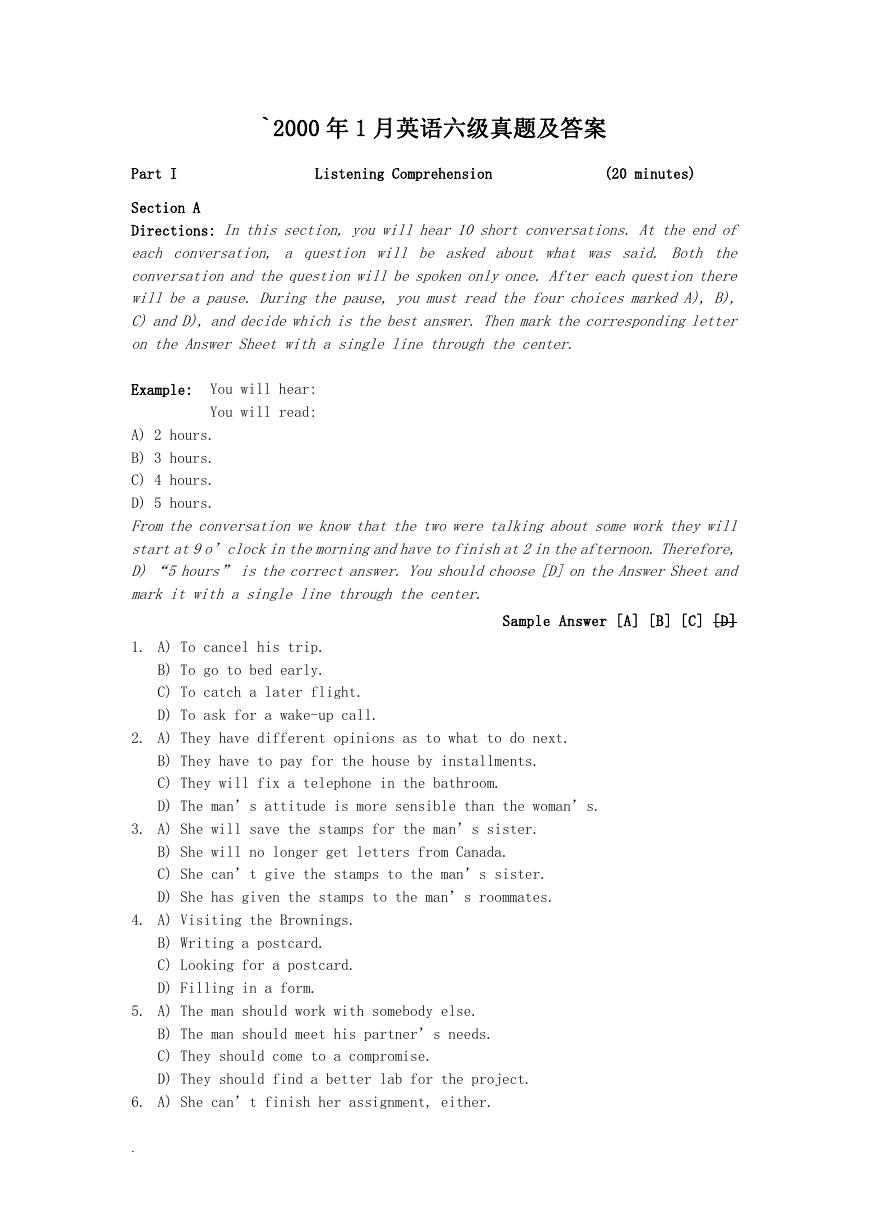
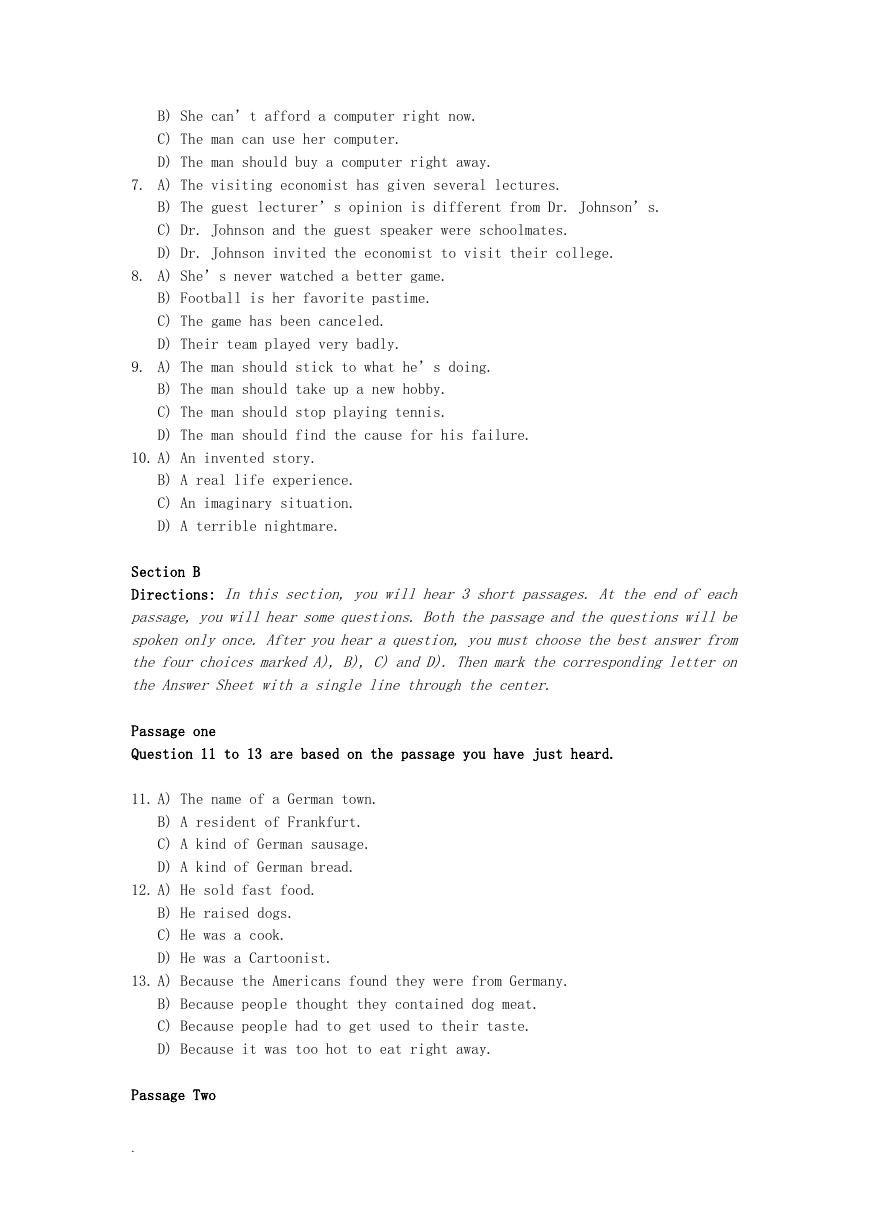
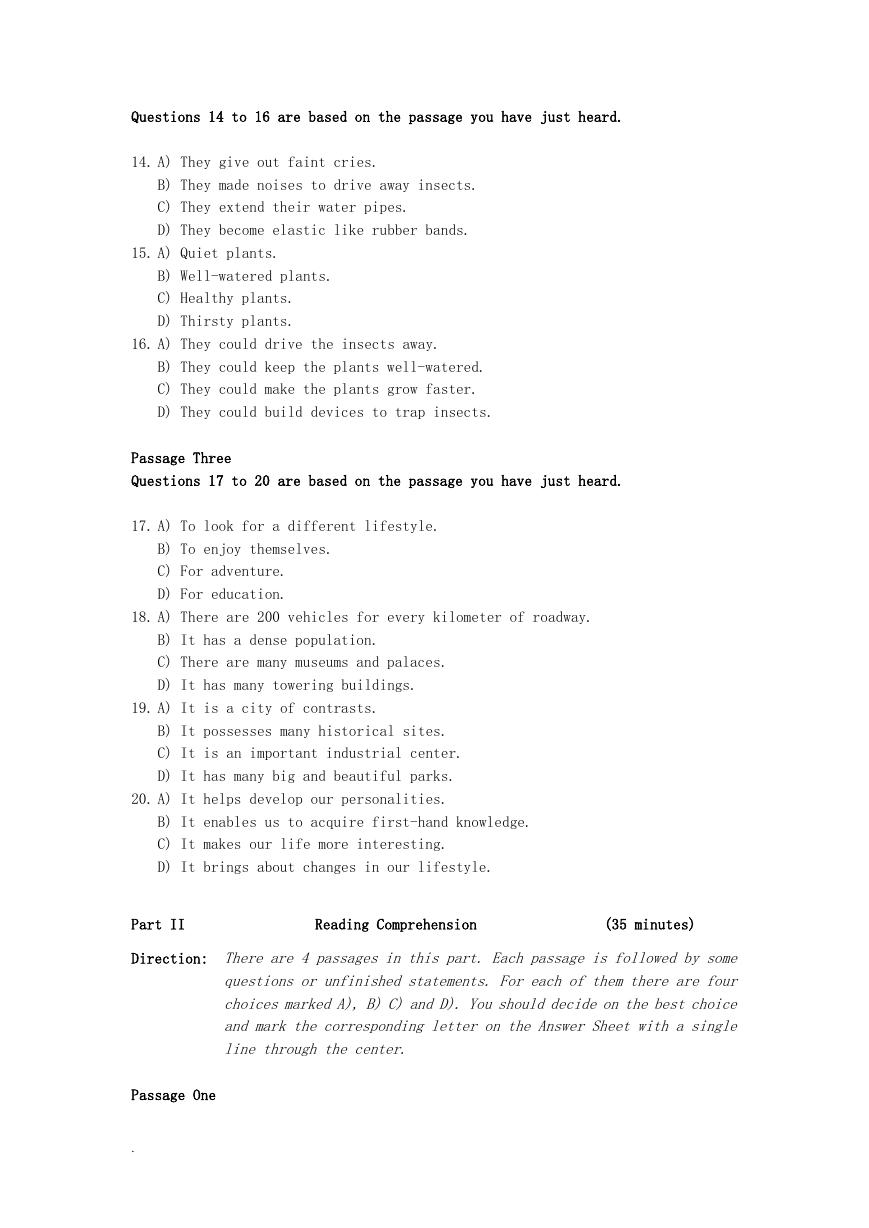
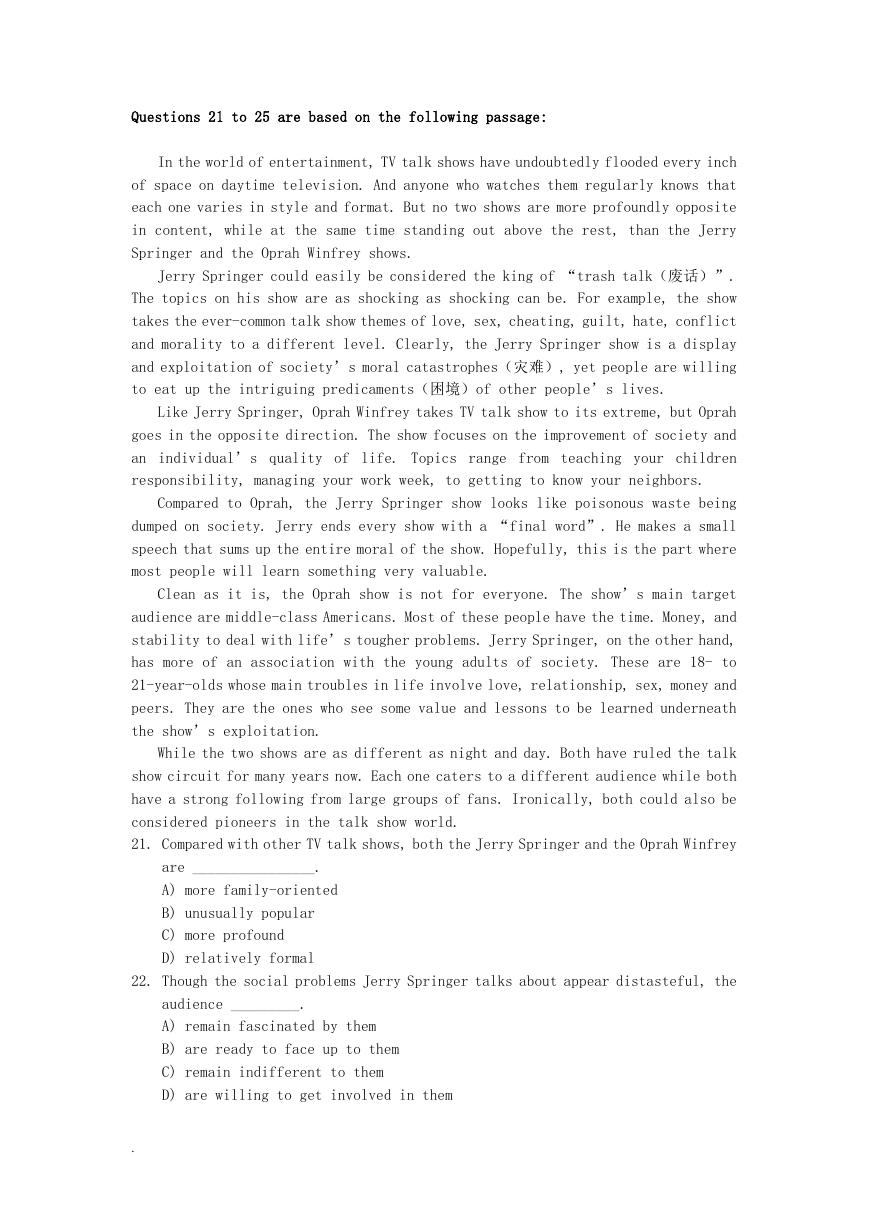


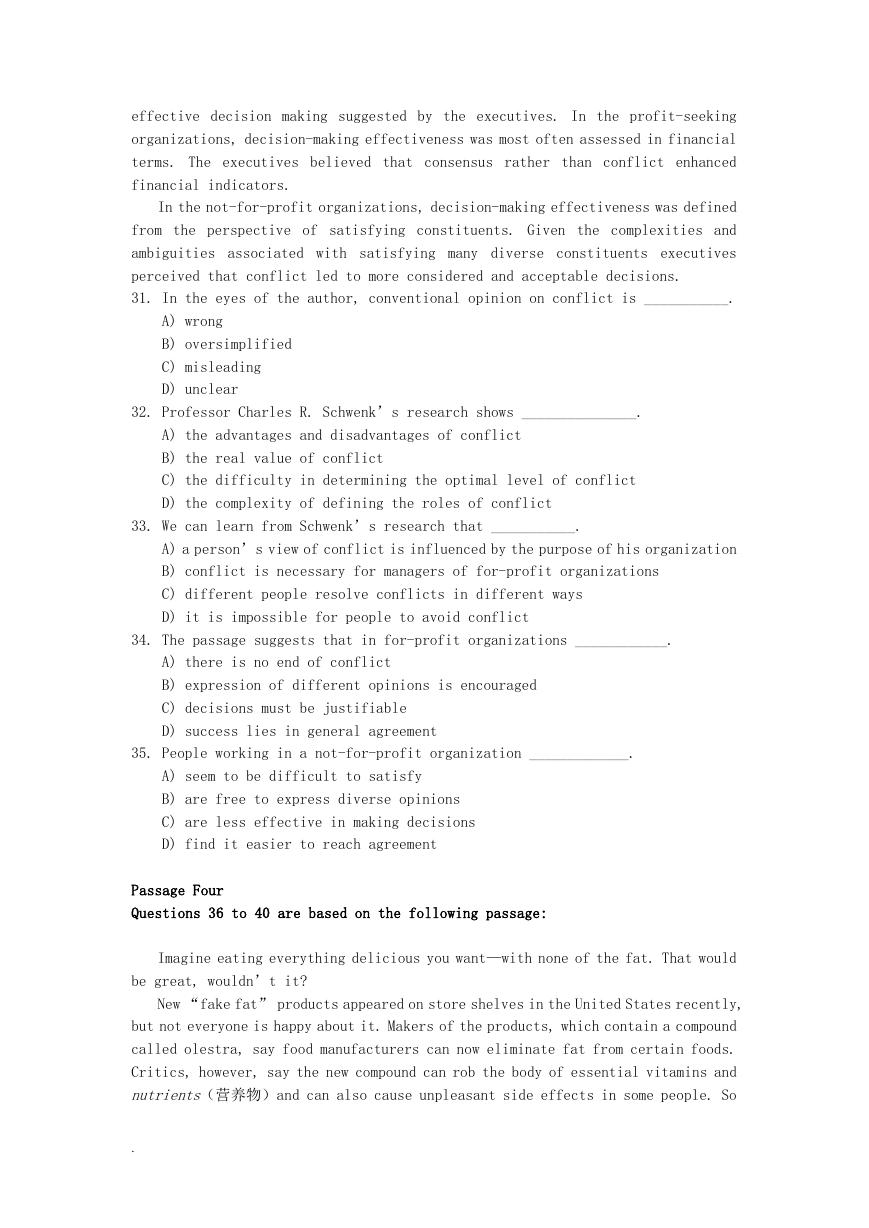









 2023年江西萍乡中考道德与法治真题及答案.doc
2023年江西萍乡中考道德与法治真题及答案.doc 2012年重庆南川中考生物真题及答案.doc
2012年重庆南川中考生物真题及答案.doc 2013年江西师范大学地理学综合及文艺理论基础考研真题.doc
2013年江西师范大学地理学综合及文艺理论基础考研真题.doc 2020年四川甘孜小升初语文真题及答案I卷.doc
2020年四川甘孜小升初语文真题及答案I卷.doc 2020年注册岩土工程师专业基础考试真题及答案.doc
2020年注册岩土工程师专业基础考试真题及答案.doc 2023-2024学年福建省厦门市九年级上学期数学月考试题及答案.doc
2023-2024学年福建省厦门市九年级上学期数学月考试题及答案.doc 2021-2022学年辽宁省沈阳市大东区九年级上学期语文期末试题及答案.doc
2021-2022学年辽宁省沈阳市大东区九年级上学期语文期末试题及答案.doc 2022-2023学年北京东城区初三第一学期物理期末试卷及答案.doc
2022-2023学年北京东城区初三第一学期物理期末试卷及答案.doc 2018上半年江西教师资格初中地理学科知识与教学能力真题及答案.doc
2018上半年江西教师资格初中地理学科知识与教学能力真题及答案.doc 2012年河北国家公务员申论考试真题及答案-省级.doc
2012年河北国家公务员申论考试真题及答案-省级.doc 2020-2021学年江苏省扬州市江都区邵樊片九年级上学期数学第一次质量检测试题及答案.doc
2020-2021学年江苏省扬州市江都区邵樊片九年级上学期数学第一次质量检测试题及答案.doc 2022下半年黑龙江教师资格证中学综合素质真题及答案.doc
2022下半年黑龙江教师资格证中学综合素质真题及答案.doc